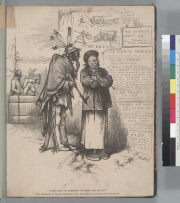The New Chinatown Monologues
From The Peopling of NYC
Contents |
An Introduction
Living in a city that never sleeps, New Yorkers often forget about the long and rich history of their home. Only by learning from the past can we begin look toward the future.
Chinese immigration brought immense changes to the city landscape. This Wiki attempts to chronicle the face of Chinese immigration by delving into the myth of the model minority, the ethnic enclave(s) of Chinatown, and the assimilation of the Chinese into mainstream American society.
Ethnic Enclave
Manhattan's Chinatown serves as a transition from Chinese society to American society. An area rich with social services and community support for Chinese immigrants, Chinatown is a safe and familiar haven for those Chinese who find themselves in a foreign country.
A. History of Immigration
Chinese immigration to American shores came in waves, spanning over 150 years, and a geographical distance of over 7,000 miles.
The First Wave
The Second Wave
B. Life and Work in Chinatown
Chinatown has been a safe haven, a work environment, and overall an ethnic enclave for the generations of immigrants in New York City for well over a century now. This section aims to explore the relationships within Chinatown, between the different waves of Chinese immigrants. It also explores Chinatown as a workplace and as a living environment.
C. Other Chinatowns
In the 1880s, due to increasing discrimination and violence against the Chinese for supposedly "stealing American jobs," Chinese immigrants moved from the West Coast to the East Coast. They settled in large cities where there were more employment opportunities and where they could easily blend in with the diverse population. One of these cities was New York City where the original Chinatown in Manhattan expanded to Flushing, Queens and Sunset Part, Brooklyn.
Flushing, Queens
Sunset Park, Brooklyn
Assimilation
A. Generation Gaps
This section explores the growing cultural gap between first generation Chinese immigrants (Chinese-born Americans - CBAs) and second generation immigrants (American-born Chinese - ABCs). It also delves into the reasons for the expansion of the gap as well as the impact of American culture on the growth of Chinese culture in America and the American-born Chinese who are forced to choose between two diverse lifestyles.
B. Religion
Chinatown is by no means a homogenous area when it comes to religion, it contains many religious institutions that represent a number of different traditions. The leading religious institutions in the enclave are Buddhism, Taoism, and various demoninations of Christianity, including both Catholics and Protestants.
C. The Fuzhounese Experience
The Fuzhounese make up the bulk of the newest wave in immigration from China. Their experience differs greatly from that of their predecessors.
D. Outside Voices
Political Cartoons Anti-Chinese Political Cartoons: United States 1850-1925 - Far from being considered a "model minority," when the first waves of Chinese immigration came to the West Coast in the 1840s, they were feared for their work ethic and compared with African-Americans and Native Americans.
Intolerance, Legislative Harassment, and Exclusion: Chinese immigrants endured a wave of violent racist attacks during their first few decades in the United States. All across the country, especially in areas such as Seattle, Los Angeles, and small towns in Wyoming, the Chinese were forced to withstand a movement of murder and persecution against them...
Model Minority
A. Politics and Community Services
Chinese Americans have made great progress advancing their political interests while still preserving an unique cultural identity, which is largely preserved by the Chinatowns located in all major U.S. cities.
Political Activities
Community Organizations
Cultural Preservation
The Original Chinatown Monologues
Here you will find a collection of original monologues about the Chinese in America created by students.
Monologue Videos
Monologue Transcripts
Interviews
More Information about Professor Kenneth Guest
MoCA: Museum of Chinese in Americas
Anonymous, Chinatown Store Owner
Experiences
A collection of thoughts and stories from student explorations of Chinatown.
One Day in the Life of a Busboy
Our exploration of Chinatown. An Interactive Tour
More Information
The West Coast
A la California. Sketch of Life in the Golden State, by Col. Albert S. Evans
Opium Den
The Story of Chinatown
Gold Rush
Miscellanious
How the Other Half Lives by Jacob Riis
History of Chinese Immigration
About
This Wiki was designed and created by students of the Macaulay Honors College of Baruch.
Hsi Chan <Hsi's Bio>
Bo Chen <Bo's Bio>
Bernard Cruz <Bernard's Bio>
Alexander Gizersky <Alex's Bio>
Raymond Huynh <Raymond's Bio>
Michelle Lee <Michelle's Bio>
Vanessa Tan <Vanessa's Bio>
Shimin Zhang <Shimin's Bio>
Special thanks to members of the Baruch Faculty.
Professor Ted Henken <Ted's Bio>
Tech Fellow William Hampton-Sosa






